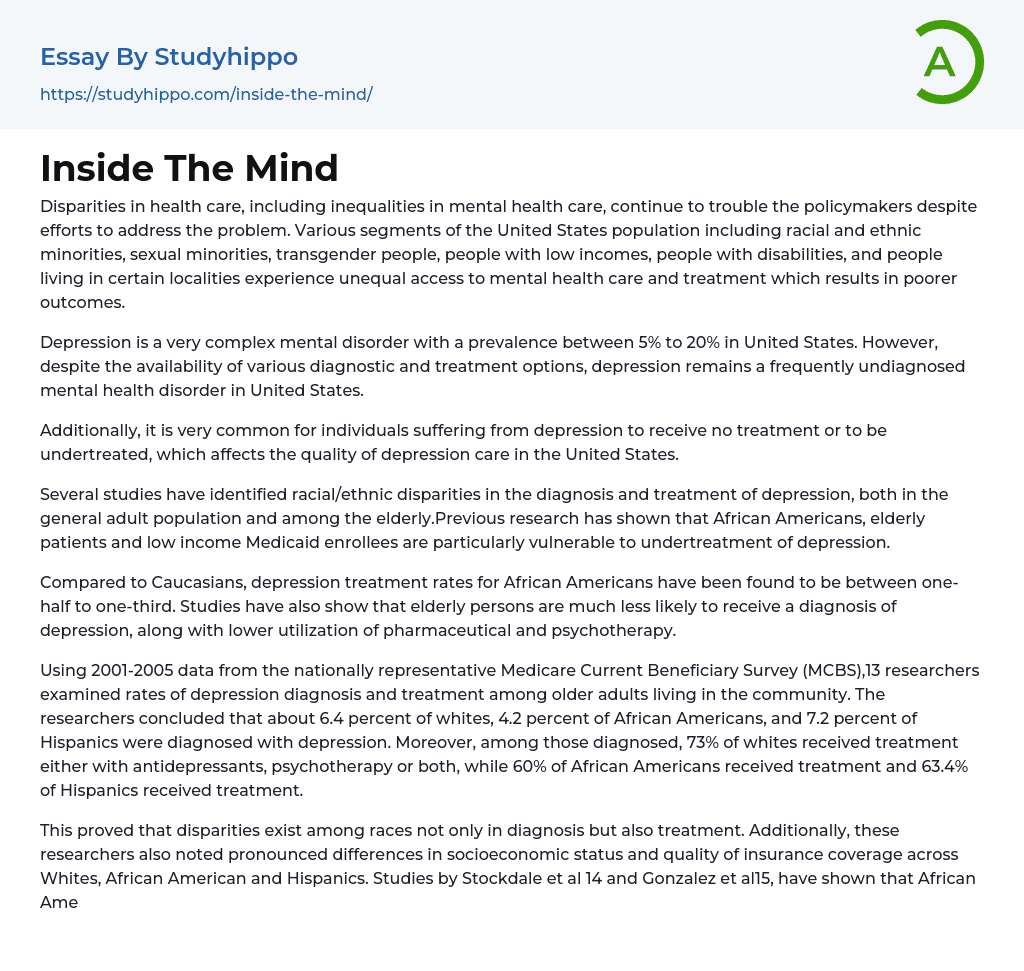Despite efforts by policymakers to address healthcare disparities, including inequalities in mental health care, they continue to struggle with the issue.
There is unequal access to mental health care and treatment in the United States among various groups of people. These groups include racial and ethnic minorities, sexual minorities, transgender individuals, those with low incomes, people with disabilities, and residents of specific areas. Unfortunately, these disparities result in worse outcomes for these populations.
The prevalence of depression in the US population can range from 5% to 20%. However, even with diagnostic tools and treatments available, depression often goes undiagnosed or untreated. Many individuals suffering from depression do not receive appropriate treatment, leading to a lower quality of care for depression within the country.
Research has demonstrated that there are discrepancies in diagnosing and treating depression based on race/ethnicity within both the gene
...ral adult population and elderly individuals. Previous studies have indicated that African Americans, elderly patients, and low-income Medicaid enrollees are particularly at high risk for undertreatment when it comes to managing their depression.
According to research, African Americans have significantly lower rates of depression treatment compared to Caucasians, estimated to be around one-half to one-third. Furthermore, elderly individuals are less likely to receive a diagnosis for depression and utilize pharmaceutical and psychotherapy treatments. To investigate the diagnosis and treatment rates in older adults within the community, researchers analyzed data from the Medicare Current Beneficiary Survey between 2001-2005. The results showed that approximately 6.4 percent of whites, 4.2 percent of African Americans, and 7.2 percent of Hispanics were diagnosed with depression. Among those who received a diagnosis, 73% of whites underwent treatment through antidepressants, psychotherapy, or both; however, this
percentage was lower for African Americans at 60% and Hispanics at 63.4%.
Research has confirmed disparities in the diagnosis and treatment of individuals from different races, highlighting the existence of such inequalities. Socioeconomic status and insurance coverage quality also vary significantly among Whites, African Americans, and Hispanics. Stockdale et al (14) and Gonzalez et al (15) conducted studies demonstrating that individuals of African American descent with depression tend to receive lower-quality care compared to White Americans. Additionally, Gonzalez et al (15) discovered that clinicians were less likely to use guideline-concordant therapies for African American or Mexican American patients compared to White Americans or individuals from other ethnic backgrounds. Furthermore, ethnic minorities, including African Caribbeans, also experience underdiagnosis and undertreatment. A specific study revealed that predominantly white clinicians often misunderstand and fear the African Caribbean community due to their distinct speech patterns, language use, and gestures; perceiving them as black, bad, mad, and dangerous.
In a study conducted by Strothers et al7, the utilization of antidepressant treatment was investigated in a population of low-income elderly Medicaid patients ranging from 65 to 84 years old who had been diagnosed with depression. The sample consisted of individuals from various racial backgrounds, including Caucasian, African American, Hispanic, and Asian. The results indicated that around 24.2% of these patients were not prescribed any form of antidepressant medication.
< p > The study identified variations in treatment based on factors such as gender, geographical location, and long-term care approach. Additionally, ethnicity played a significant role, with African American patients having the lowest likelihood (37.1%) of receiving medication treatment. On the other hand, Hispanics had a lower rate of non-treatment (23.6%), followed by Caucasians (22.4%)
and Asians (13.8%). These disparities may be influenced by factors at the patient, provider, and systemic levels. It is possible that at the patient level, African Americans hold a less favorable perception of medication treatment compared to white patients and prefer counseling over drug therapy.< /p >
The notion is that African Americans frequently depend on informal sources such as pastors, spiritual healers, family, and friends for care. Consequently, this may lead to skepticism towards doctors' recommendations for depression treatment. Furthermore, it is important to consider provider factors such as potential stereotypes or bias. Additionally, the patient-physician relationship, a vital aspect of accurate diagnosis and effective depression treatment, appears to be less strong among African Americans.
One possible cause for disparities in the treatment of depression among ethnic minority groups is systemic issues, such as a high number of individuals without insurance. To address these disparities, various approaches can be taken. An effective strategy involves offering financial incentives to psychiatrists and other healthcare professionals serving underserved communities. This approach aims to guarantee that depressed individuals from minority populations, who may lack access to essential care, receive the necessary support.
Including cross-cultural education in the professional training of healthcare workers can contribute to reducing disparities in healthcare. To tackle these disparities, it is crucial to employ approaches like improving healthcare financing, guaranteeing equal access to care irrespective of caste or creed, and introducing educational initiatives focused on enhancing provider-patient communication.
- Adhd essays
- Antisocial Personality Disorder essays
- Anxiety essays
- Bipolar Disorder essays
- Depression essays
- Depression And Anxiety essays
- Dyslexia essays
- Learning Disability essays
- Major Depressive Disorder essays
- Mental Disorder essays
- Mental Illness essays
- Psychosis essays
- Schizophrenia essays
- Stress essays
- Suicide essays




